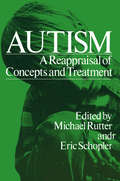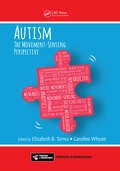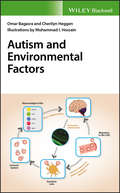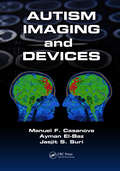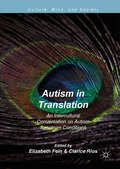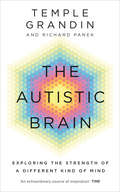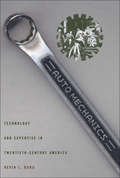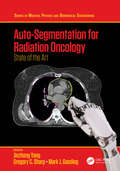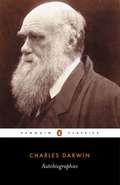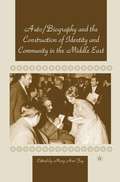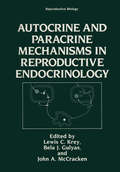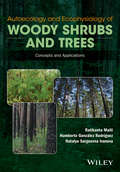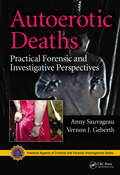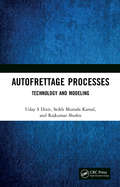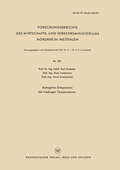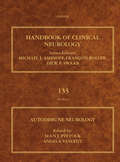- Table View
- List View
Autism: A Reappraisal of Concepts and Treatment (Child Behavior and Development)
by Michael Rutter Eric SchoplerThis volume aims to provide the reader with an up-to-date account of knowledge, research, education, and clinical practice in the field of au tism, from an international perspective. The emphasis throughout is on the growing points of knowledge and on the new developments in prac tice. We have tried to keep a balance between the need for rigorous research and systematic evaluation and the importance of expressing new ideas and concepts so that they may influence thinking at a stage when questions are being formulated and fresh approaches to treatment are being developed. The book had its origins in the 1976 International Symposium on Autism held in St. Gallen, Switzerland but it is not in any sense a proceed ings of that meeting. Most papers have been extensively rewritten to provide a fuller coverage of the topic and also to take account of the issues raised at the meeting. Discussion dialogues have been revised and re structured to stand as self-contained chapters. Many significant contribu tions to the conference have not been induded in order to maintain the balance of a definitive review; however a few extra chapters have been added to fill crucial gaps 0 We hope the result is a vivid picture ofthe current state of the art. As editors we have been most impressed by the advances since the 1970 international conference in London.
Autism: The Movement Sensing Perspective (Foundations and Innovations in Neurobiology)
by Elizabeth B. Torres Caroline WhyattAutism: The Movement Sensing Perspective is the result of a collaborative effort by parents, therapists, clinicians, and researchers from all disciplines in science including physics, engineering, and applied mathematics. This book poses questions regarding the current conceptualization and approach to the study of autism, providing an alternative unifying data-driven framework grounded in physiological factors. This book reaches beyond subjective descriptions of autistic phenomena and embraces a new era of objective measurements, analyses, and statistical inferences. The authors harness activities from the nervous systems across the brain and body (often in tandem), and introduce a platform for the comprehensive personalized phenotyping of individuals with autism. The impact of this approach is discussed to advance the development of tailored treatments options, enhance the ability to longitudinally track symptomatology, and to fundamentally empower affected individuals and their families. This book encompasses a new era for autism research and treatments, and our continuous effort to collectively empower and embrace the autistic community.
Autism: The Movement Sensing Perspective (Frontiers in Neuroscience)
by Elizabeth B. Torres Caroline WhyattAutism: The Movement Sensing Perspective is the result of a collaborative effort by parents, therapists, clinicians, and researchers from all disciplines in science including physics, engineering, and applied mathematics. This book poses questions regarding the current conceptualization and approach to the study of autism, providing an alternative unifying data-driven framework grounded in physiological factors. This book reaches beyond subjective descriptions of autistic phenomena and embraces a new era of objective measurements, analyses, and statistical inferences. The authors harness activities from the nervous systems across the brain and body (often in tandem), and introduce a platform for the comprehensive personalized phenotyping of individuals with autism. The impact of this approach is discussed to advance the development of tailored treatments options, enhance the ability to longitudinally track symptomatology, and to fundamentally empower affected individuals and their families. This book encompasses a new era for autism research and treatments, and our continuous effort to collectively empower and embrace the autistic community.
Autism and Environmental Factors
by Omar Bagasra Cherilyn HeggenExplores environmental factors during fetal development that may contribute to autism It is well documented that in the majority of the cases, an autistic child's brain has acquired the genetic and organismal abnormalities that were initiated during the first trimester of their gestational period. Yet, scientists still don’t know what is causing these abnormalities; this book explains how the human brain develops and what the critical stages are in which a fetal brain may acquire genetic and developmental abnormalities. It presents scientific data supporting previous anecdotal observations to attempt to understand the complex puzzle that is autism. From chemical fragrances to herbicides, synthetic chemicals are abundant in everyday life and this book examines the evidence surrounding these chemicals and their effects, including on the developing human brain and how that might explain certain characteristics observed in autism. Discussing various aspects of potential ASD causing factors, Autism and Environmental Factors brings together as many pieces of the autism puzzle as possible in one place to begin to clarify the picture and spark discussion to ensure a safe environment for everyone, especially our developing children. Discusses the genetic and environmental factors that may contribute to autism Covers how the human brain develops and the critical stages in which a fetal brain may acquire genetic and developmental abnormalities Describes the rapid proliferation of synthetic chemicals in our modern world and the effects on the developing human brain—endocrine-disturbing chemicals that alter DNA, epigenetics, and hormones Written in a clear and accessible style Autism and Environmental Factors is an important book for researchers and students in neuroscience, neuroanatomy, developmental neurobiology and anyone focusing on autism research.
Autism and Environmental Factors
by Omar Bagasra Cherilyn HeggenExplores environmental factors during fetal development that may contribute to autism It is well documented that in the majority of the cases, an autistic child's brain has acquired the genetic and organismal abnormalities that were initiated during the first trimester of their gestational period. Yet, scientists still don’t know what is causing these abnormalities; this book explains how the human brain develops and what the critical stages are in which a fetal brain may acquire genetic and developmental abnormalities. It presents scientific data supporting previous anecdotal observations to attempt to understand the complex puzzle that is autism. From chemical fragrances to herbicides, synthetic chemicals are abundant in everyday life and this book examines the evidence surrounding these chemicals and their effects, including on the developing human brain and how that might explain certain characteristics observed in autism. Discussing various aspects of potential ASD causing factors, Autism and Environmental Factors brings together as many pieces of the autism puzzle as possible in one place to begin to clarify the picture and spark discussion to ensure a safe environment for everyone, especially our developing children. Discusses the genetic and environmental factors that may contribute to autism Covers how the human brain develops and the critical stages in which a fetal brain may acquire genetic and developmental abnormalities Describes the rapid proliferation of synthetic chemicals in our modern world and the effects on the developing human brain—endocrine-disturbing chemicals that alter DNA, epigenetics, and hormones Written in a clear and accessible style Autism and Environmental Factors is an important book for researchers and students in neuroscience, neuroanatomy, developmental neurobiology and anyone focusing on autism research.
Autism Imaging and Devices
by Manuel F. Casanova Ayman El-Baz Jasjit S. SuriThis book covers state-of-the-art medical image analysis approaches currently pursued in autism research. Chapters cover recent advances in diagnosis using structural neuroimaging. All aspects of imaging are included, such as electrophysiology (EEG, ERP, QEEG, and MEG), postmortem techniques, and advantages and difficulties of depositing/acquiring images in larger databases. The book incorporates 2D, 3D, and 4D imaging and advances scientific research within the broad field of autism imaging.
Autism Imaging and Devices
by Jasjit S. Suri Manuel F. Casanova Ayman El-BazThis book covers state-of-the-art medical image analysis approaches currently pursued in autism research. Chapters cover recent advances in diagnosis using structural neuroimaging. All aspects of imaging are included, such as electrophysiology (EEG, ERP, QEEG, and MEG), postmortem techniques, and advantages and difficulties of depositing/acquiring images in larger databases. The book incorporates 2D, 3D, and 4D imaging and advances scientific research within the broad field of autism imaging.
Autism in Translation: An Intercultural Conversation on Autism Spectrum Conditions (Culture, Mind, and Society)
by Elizabeth Fein Clarice RiosAutism is a complex phenomenon that is both individual and social. Showing both robust similarities and intriguing differences across cultural contexts, the autism spectrum raises innumerable questions about self, subjectivity, and society in a globalized world. Yet it is often misrepresented as a problem of broken bodies and disordered brains. So, in 2015, a group of interdisciplinary scholars gathered in Rio de Janeiro, Brazil for an intellectual experiment: a workshop that joined approaches from psychological anthropology to the South American tradition of Collective Health in order to consider autism within social, historical, and political settings. This book is the product of the ongoing conversation emerging from this event. It contains a series of comparative histories of autism policy in Italy, Brazil, and the United States; focuses on issues of voice, narrative, and representation in autism; and examines how the concept of autism shapes both individual lives and broader social and economic systems. Featuring contributions from:Michael BakanBenilton BezerraPamela BlockM. Ariel Cascio Jurandir Freire CostaBárbara Costa AndradaCassandra EvansElizabeth Fein Clara Feldman Roy Richard GrinkerRossano LimaFrancisco OrtegaDawn Prince-HughesClarice Rios Laura Sterponi Thomas S. WeisnerEnrico Valtellina
Autism in Translation: An Intercultural Conversation on Autism Spectrum Conditions (Culture, Mind, and Society)
by Elizabeth Fein Clarice RiosAutism is a complex phenomenon that is both individual and social. Showing both robust similarities and intriguing differences across cultural contexts, the autism spectrum raises innumerable questions about self, subjectivity, and society in a globalized world. Yet it is often misrepresented as a problem of broken bodies and disordered brains. So, in 2015, a group of interdisciplinary scholars gathered in Rio de Janeiro, Brazil for an intellectual experiment: a workshop that joined approaches from psychological anthropology to the South American tradition of Collective Health in order to consider autism within social, historical, and political settings. This book is the product of the ongoing conversation emerging from this event. It contains a series of comparative histories of autism policy in Italy, Brazil, and the United States; focuses on issues of voice, narrative, and representation in autism; and examines how the concept of autism shapes both individual lives and broader social and economic systems. Featuring contributions from:Michael BakanBenilton BezerraPamela BlockM. Ariel Cascio Jurandir Freire CostaBárbara Costa AndradaCassandra EvansElizabeth Fein Clara Feldman Roy Richard GrinkerRossano LimaFrancisco OrtegaDawn Prince-HughesClarice Rios Laura Sterponi Thomas S. WeisnerEnrico Valtellina
The Autistic Brain: Thinking Across The Spectrum
by Temple Grandin Richard PanekWINNER OF 'BEST NON FICTION' IN THE GOODREADS CHOICE AWARDS 2013It's estimated that one in almost a hundred people are diagnosed as being on the autistic spectrum but there is far more hope for them today than ever before thanks to groundbreaking new research.In this fascinating and highly readable book, Temple Grandin offers her own experience as an autistic person alongside remarkable new discoveries about the autistic brain, as well as genetic research. She also highlights long-ignored sensory problems as well as the need to treat autism symptom by symptom, rather than with an umbrella diagnosis. Most exciting of all, she argues that raising and educating children on the autistic spectrum needs to be less about focusing on their weaknesses, and more about fostering their unique contributions.
Auto Mechanics: Technology and Expertise in Twentieth-Century America (Studies in Industry and Society)
by Kevin L. BorgThe history of automobiles is not just the story of invention, manufacturing, and marketing; it is also a story of repair. Auto Mechanics opens the repair shop to historical study—for the first time—by tracing the emergence of a dirty, difficult, and important profession.Kevin L. Borg's study spans a century of automotive technology—from the horseless carriage of the late nineteenth century to the "check engine" light of the late twentieth. Drawing from a diverse body of source material, Borg explores how the mechanic’s occupation formed and evolved within the context of broad American fault lines of class, race, and gender and how vocational education entwined these tensions around the mechanic’s unique expertise. He further shows how aspects of the consumer rights and environmental movements, as well as the design of automotive electronics, reflected and challenged the social identity and expertise of the mechanic.In the history of the American auto mechanic, Borg finds the origins of a persistent anxiety that even today accompanies the prospect of taking one's car in for repair.
Auto-Segmentation for Radiation Oncology: State of the Art (Series in Medical Physics and Biomedical Engineering)
by Jinzhong Yang, Gregory C. Sharp, and Mark J. GoodingThis book provides a comprehensive introduction to current state-of-the-art auto-segmentation approaches used in radiation oncology for auto-delineation of organs-of-risk for thoracic radiation treatment planning. Containing the latest, cutting edge technologies and treatments, it explores deep-learning methods, multi-atlas-based methods, and model-based methods that are currently being developed for clinical radiation oncology applications. Each chapter focuses on a specific aspect of algorithm choices and discusses the impact of the different algorithm modules to the algorithm performance as well as the implementation issues for clinical use (including data curation challenges and auto-contour evaluations). This book is an ideal guide for radiation oncology centers looking to learn more about potential auto-segmentation tools for their clinic in addition to medical physicists commissioning auto-segmentation for clinical use. Features: Up-to-date with the latest technologies in the field Edited by leading authorities in the area, with chapter contributions from subject area specialists All approaches presented in this book are validated using a standard benchmark dataset established by the Thoracic Auto-segmentation Challenge held as an event of the 2017 Annual Meeting of American Association of Physicists in Medicine
Auto-Segmentation for Radiation Oncology: State of the Art (Series in Medical Physics and Biomedical Engineering)
by Jinzhong Yang Gregory C. Sharp Mark J. GoodingThis book provides a comprehensive introduction to current state-of-the-art auto-segmentation approaches used in radiation oncology for auto-delineation of organs-of-risk for thoracic radiation treatment planning. Containing the latest, cutting edge technologies and treatments, it explores deep-learning methods, multi-atlas-based methods, and model-based methods that are currently being developed for clinical radiation oncology applications. Each chapter focuses on a specific aspect of algorithm choices and discusses the impact of the different algorithm modules to the algorithm performance as well as the implementation issues for clinical use (including data curation challenges and auto-contour evaluations). This book is an ideal guide for radiation oncology centers looking to learn more about potential auto-segmentation tools for their clinic in addition to medical physicists commissioning auto-segmentation for clinical use. Features: Up-to-date with the latest technologies in the field Edited by leading authorities in the area, with chapter contributions from subject area specialists All approaches presented in this book are validated using a standard benchmark dataset established by the Thoracic Auto-segmentation Challenge held as an event of the 2017 Annual Meeting of American Association of Physicists in Medicine
Autobiographies: Edited By His Son Francis Darwin (Mobi Classics Series)
by Charles DarwinThe Autobiographies of Charles Darwin (1809-82) provide a fascinating glimpse into the mind of one of the world's intellectual giants. They begin with engaging memories of his childhood and youth and of his burgeoning scientific curiosity and love of the natural world, which led to him joining the expedition on the Beagle. Darwin follows this with survey of his career and ends with a reckoning of his life's work. Interspersed with these recollections are fascinating portraits - from his devoted wife Emma and his talented father, both bullying and kind, to the leading figures of the Victorian scientific world he counted among his friends, including Lyell and Huxley. Honest and illuminating, these memoirs reveal a man who was isolated by his controversial beliefs and whose towering achievements were attained by a life-long passion for the discoveries of science.
Autobiography and the Construction of Identity and Community in the Middle East
by NA NARanging from the early modern period to the present day, this edited collection uses biography as a window into the history of the Arab-Islamic Middle East. The contributors reinterpret the lives of the famous such as George Antonius and Doria Shafiq and rediscover the lives of individuals previously consigned to the margins of history, including the notorious individuals of 17th-century Syria and the 20th-century Palestinian activist Kulthum Auda. The book also draws on the biographical tradition of Arab historical writing, including biographical dictionaries, for an understanding of the region s social and cultural history. Interdisciplinary in scope and theoretically informed, this volume brings to light individual lives which are essential to an understanding of Middle Eastern history.
Autocrine and Paracrine Mechanisms in Reproductive Endocrinology (Reproductive Biology)
by L. KreyThere is a prov1s10n in the charter of each Study Section of the Division of Research Grants at the National Institutes of Health that stipulates that "workshops" are to be held periodically to aid Study Section members in their appraisals of recent developments in their fields and to identify future challenges worthy of investigation. The Reproductive Endocrinology Study Section was established on December 13, 1985 to review research grants and research training activities relating to reproductive endocrinology, including aspects of management of reproductive endocrine disorders and hormonal imbalances as related to infertility and during pregnancy and puberty, breast cancer and prostate cancer. It held its first workshop, entitled, "Autocrine and Paracrine Mechanisms in Reproductive Endocrinology," in October, 1988 in Shrewsbury, MA at The Worcester Foundation for Experimental Biology. The proceedings of this workshop, which are detailed herein, reflect the fact that autocrine and paracrine interactions are rapidly being accepted as an exciting area of research by scientists investigating the physiological and biochemical mechanisms of hormone action in the male and female reproductive systems. The material covered is novel and wide-ranging, extending from theoretical considerations of mechanisms of growth factor action and the role of cell cycle stage in determining hormone action to investigations of autocrine and paracrine interactions during development to discussions of the potential clinical ramifications of the basic research findings. Such an extensive inventory is necessary for two reasons.
Autoecology and Ecophysiology of Woody Shrubs and Trees: Concepts and Applications
by Ratikanta Maiti Humberto Gonzalez Rodriguez Natalya Sergeevna IvanovaForest trees and shrubs play vital ecological roles, reducing the carbon load from the atmosphere by using carbon dioxide in photosynthesis and by the storage of carbon in biomass and wood as a source of energy. Autoecology deals with all aspects of woody plants; the dynamism of populations, physiological traits of trees, light requirements, life history patterns, and physiological and morphological characters. Ecophysiology is defined by various plant growth parameters such as leaf traits, xylem water potential, plant height, basal diameter, and crown architecture which are, in turn, influenced by physiological traits and environmental conditions in the forest ecosystem. In short, this book details research advances in various aspects of woody plants to help forest scientists and foresters manage and protect forest trees and plan their future research. Autoecology and Ecophysiology of Woody Shrubs and Trees is intended to be a guide for students of woody plant autoecology and ecophysiology, as well as for researchers in this field. It is also an invaluable resource for foresters to assist in effective management of forest resources.
Autoecology and Ecophysiology of Woody Shrubs and Trees: Concepts and Applications
by Ratikanta Maiti Humberto Gonzalez Rodriguez Natalya Sergeevna IvanovaForest trees and shrubs play vital ecological roles, reducing the carbon load from the atmosphere by using carbon dioxide in photosynthesis and by the storage of carbon in biomass and wood as a source of energy. Autoecology deals with all aspects of woody plants; the dynamism of populations, physiological traits of trees, light requirements, life history patterns, and physiological and morphological characters. Ecophysiology is defined by various plant growth parameters such as leaf traits, xylem water potential, plant height, basal diameter, and crown architecture which are, in turn, influenced by physiological traits and environmental conditions in the forest ecosystem. In short, this book details research advances in various aspects of woody plants to help forest scientists and foresters manage and protect forest trees and plan their future research. Autoecology and Ecophysiology of Woody Shrubs and Trees is intended to be a guide for students of woody plant autoecology and ecophysiology, as well as for researchers in this field. It is also an invaluable resource for foresters to assist in effective management of forest resources.
Autoerotic Deaths: Practical Forensic and Investigative Perspectives
by Anny Sauvageau Vernon J. GeberthAutoerotic Deaths: Practical Forensic and Investigative Perspectives is a collaboration between two internationally known experts who combine their extensive experience to present a scientific, modern view of autoerotic death complete with a wide variety of exquisite case histories, photographs, and investigator tips.Chief Medical Examiner Anny Sau
Autofrettage Processes: Technology and Modelling
by Uday S Dixit Seikh Mustafa Kamal Rajkumar ShufenAutofrettage Processes: Technology and Modeling deals with the technology and modeling of autofrettage processes, explaining the subject in a lucid manner. It highlights how the theory of plasticity and finite element modeling are applied in the modeling of autofrettage processes. Aimed at senior students of mechanical, production, automobile, and chemical engineering, it has the potential to directly benefit practicing engineers and industrials, owing to the inclusion of topics like thermal autofrettage. Key Features: Provides a general introduction to autofrettage Covers the application of theory of plasticity and finite element modeling of autofrettage processes Offers exposure to newer autofrettage processes that to date have not been implemented in industries, along with useful practical data
Autofrettage Processes: Technology and Modelling
by Uday S Dixit Seikh Mustafa Kamal Rajkumar ShufenAutofrettage Processes: Technology and Modeling deals with the technology and modeling of autofrettage processes, explaining the subject in a lucid manner. It highlights how the theory of plasticity and finite element modeling are applied in the modeling of autofrettage processes. Aimed at senior students of mechanical, production, automobile, and chemical engineering, it has the potential to directly benefit practicing engineers and industrials, owing to the inclusion of topics like thermal autofrettage. Key Features: Provides a general introduction to autofrettage Covers the application of theory of plasticity and finite element modeling of autofrettage processes Offers exposure to newer autofrettage processes that to date have not been implemented in industries, along with useful practical data
Autogenes Entspannen bei niedrigen Temperaturen (Forschungsberichte des Wirtschafts- und Verkehrsministeriums Nordrhein-Westfalen #531)
by Karl KrekelerAutoimmune Neurology (ISSN #Volume 133)
by Sean J. Pittock Angela VincentAutoimmune Neurology presents the latest information on autoimmune neurologic disease, the immune response to the body where organs run wild, causing the immune system to attack itself. Autoimmunity is a main element in numerous nervous system diseases and can target any structure within the central or peripheral nervous system. Over the past 20 years, significant advances in our understanding of the pathophysiology of autoimmune disorders, including the use of biomarkers has led to new diagnosis and treatment options. Neurologic conditions associated with autoimmune reactions include dementia, neuromuscular disease, epilepsy, sleep disorders, diabetes, and other common neurologic disorders and disease. This current tutorial-reference will be a must-have title for clinical neurologists, research neurologists, neuroscientists, and any medical professional working with autoimmune disease and disorders.Includes comprehensive coverage of autoimmune neurologyDetails the latest techniques for the study, diagnosis, and treatment of diseases and disorders, including dementia, neuromuscular disease, epilepsy, and sleep disordersPresents a focused reference for clinical practitioners and the clinical neurology and neurology research communities
